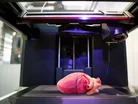3D Systems announces expansion in bioprinting

3D Systems, the company that released the first commercial 3D printer, has announced a breakthrough in bioprinting technology that could enable 3D printing of regenerative tissue.
The US-based firm is set to significantly expand its development efforts in regenerative medicine and bioprinting solutions, a decision that was driven by the progress made in collaboration with United Therapeutics Corporation and its organ manufacturing and transplantation-focused subsidiary, Lung Biotechnology PBC, on the development of 3D printing systems for solid-organ scaffolds.
As part of the plans 3D Systems will invest, develop, and commercialize solutions for a variety of applications n regenerative medicine, including the development of non-solid organ applications.
In 2020, 3D Systems and United Therapeutics achieved significant progress in the development of a next-generation manufacturing platform solution for lung scaffolds. This is capable of full size, vascularized, micron-level printing. Combined, the two companies have made advances in lung modelling, 3D printing, as well as material formulation using a unique rhCollagen, used in tissue regeneration.
The firm’s newly developed Print to Perfusion™ process enables 3D printing of high-resolution scaffolds that can be suffused with living cells to create tissues. 3D Systems is also expanding its high-speed Figure 4® technology through innovation tailored to bioprinting and regenerative medicine.
Building on these capabilities, 3D Systems and its partners will be able to advance innovation into numerous applications within the human body. The company also believes this gives them the potential to enable novel laboratory testing methods to accelerate the development of new drug therapies while reducing the need for animal testing.
Chuck Hull, co-founder, executive vice president and chief technology officer, 3D Systems said: “Over the last years as bioprinting and regenerative medicine have evolved, we’ve seen a growing need to place cells at high-resolution in a nurturing matrix to produce complex tissues.
“Precise 3D printing with hydrogels, followed by perfusion of cells into the printed scaffold is the best way to achieve this, and we are thankful our work with United Therapeutics has given us the opportunity to advance and perfect this technology.”
- 3D printing technology for personalised healthcareTechnology & AI
- Tackling the world's healthcare challenges with 3D printingMedical Devices & Pharma
- Research on the benefits of 3D printing in a trauma hospitalTechnology & AI
- How accessible 3D printing can improve quality of lifeTechnology & AI



